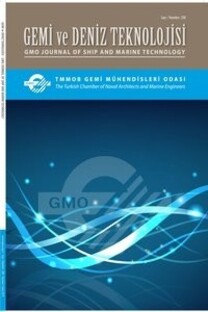HAD Metodu ile Sınır Tabaka Emme Tekniği Kullanılan Rüzgar Destekli Sevk Sistemi Geliştirilmesi
Sınır tabaka emme, HAD, Rüzgar destekli sevk, turbo-yelken, aerodinamik
Development of a Wind-Assisted Propulsion System Using Boundary Layer Suction with CFD Method
Boundary layer suction, CFD, wind-assisted propulsion, aerodynamics, turbo-sail,
___
- ANSYS (2013). Ansys CFX Solver Modelling Guide. Canonsburg: ANSYS, Inc.
- Bockmann, E., Steen, S. (2011). Wind turbine Propulsion of Ships. Second International Symposium on Marine Propulsors (SMP 11). Hamburg, Almanya, 17-18 Haziran 2011.
- Charrier, B., Constans, J., Cousteau, J., Daif, A., Malavard, L., Quinio, J. (1985). Foundation Cousteau and Windship Propulsion 1980-1985 System Cousteau Pechiney. Journal of Wind Engineering and Industrial Aerodynamics, (20), 39-60.
- Czermanski, E., Jastrząbek, A.O., Spangenberg E.F., Kozłowski, Ł., Adamowicz, M., Jankiewicz, J., Cirella, G.(2022) Implementation of the Energy Efficiency Existing Ship Index: An important but costly step towards ocean protection. Marine Policy (145).
- En.wikipedia.org/wiki/Alcyone_%281985_ship%29, [Erişim 18.11.2022].
- en.wikipedia.org/wiki/USA_17, [Erişim 18.11.2022].
- fr.cousteau.org/turbovoile.php, [Erişim 18.11.2022].
- Guerri, O., Liberge, E., Hamdouni, A. (2016). Numerical Simulation of the Turbulent Flow Around an Oval-Sail. Journal of Applied Fluid Mechanics (9) 2009-2023.
- Hcini, C., Abidi, E., Kamoun, B., Afungchui, D. (2017). A Turbosail Profile Analysis Code Based on the Panel Method. Energy, (118), 147-155.
- https://www.sail-world.com/news/235003/DynaRig-by-Southern-Spars-on-two-superyachts, [Erişim 18.11.2022].
- IMO (2011). IMO and the Environment. https://www.imo.org/en/OurWork/Environment/Pages/De]fault.aspx [Erişim 03.12.2022].
- IMO (2012). IMO Train the Trainer Course, Module 2: Ship Energy Efficiency Regulation and Related Guidelines. Londra. Ocak 2016.
- IMO (2022a). Rules on ship carbon intensity and rating system enter into force. Rules on ship carbon intensity and rating system enter into force (imo.org). [Erişim 03.12.2022].
- IMO (2022b). MEPC 78/1/Add.1 Annex 12: 2022 Guidelines on the Method of Calculation of the Attained Energy Efficiency Existing Ship Index (EEXI). 10 Haziran 2022.
- ITTC (2017). Uncertainty Analysis in CFD Verification and Validation Methodology and Procedures, 7.5-0.3-01-01. https://www.ittc.info/media/8153/75-03-01-01.pdf [Erişim 29.07.2022].
- Lindstad, E., Stokke, T., Alteskjær, A., Borgen, H., Sandaas, I. (2022) Ship of the future – A slender dry-bulker with wind assisted propulsion. Marine Transport Research (3).
- loc.gov/item/2014717912/, [Erişim 18.11.2022].
- Low, H. T., Luo, S. C., Winoto, S. H. (1991). Flow Past a Wind-Assisted Ship Propulsion Device. Ocean Engn, (18), 555-565.
- Saydam, A.Z., Küçüksu, G. N., İnsel, M., Gökçay, S. (2022). Investigation of the Influence of Wind-Assissted Propulsion Devices on Hull Design. Sustainable Development and Innovations in Marine Technologies, Taylor and Francis, London.
- Yihuai, H., Taiyou, W., Yongli, L. (2017). Numerical Simulation and Kinetic Analysis of Turbine Sail. Journal of Energy and Power Engineering, (11), 127-134).
- ISSN: 1300-1973
- Yayın Aralığı: Yılda 2 Sayı
- Başlangıç: 1955
- Yayıncı: TMMOB Gemi Mühendisleri Odası
Gemilerde Kullanılan Termik Yağ Sisteminin Performans Analizleri
Asım Sinan KARAKURT, Burak BAŞARAN, Engin Ziya ÇUBUKÇU
Tersanelerde Yüksekte Çalışma Risklerinin AHP Tabanlı PROMETHEE ile Analiz Edilmesi
Murat YORULMAZ, Mehmet Arif ÖZTÜRK
Murat BAYRAKTAR, Umur BUCAK, Hakan DEMİREL
HAD Metodu ile Sınır Tabaka Emme Tekniği Kullanılan Rüzgar Destekli Sevk Sistemi Geliştirilmesi
Gözde Nur KÜÇÜKSU, Ahmet Ziya SAYDAM
Tekne ve Makine Sigortaları Kapsamında Türk Deniz Ticaret Filosunun Risk Analizi
Tank Geometrisinin Çalkantı Kuvvetlerine Etkisi
γ Türbülans Geçiş Modelinin Kuvvet Katsayıları ve Geçiş Yer Tahmini Üzerindeki Etkisi
Kovid-19 Salgını Döneminde Türk Tersaneleri
Mehmet TANTAN, Hatice CAMGÖZ AKDAĞ, Mehtap KARAHALLI ÖZDEMİR
Gemi Sevk Gücü ve Isı Transferinin Yapısal Gelişim Teorisi ile İlişkisi
